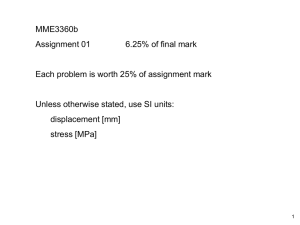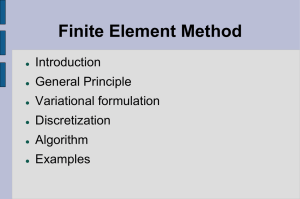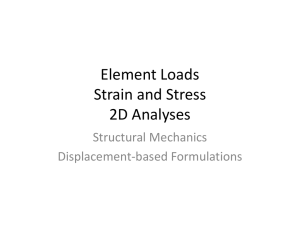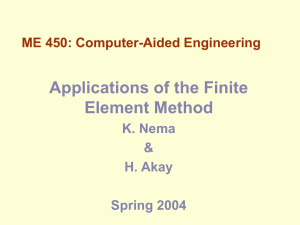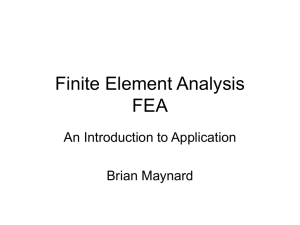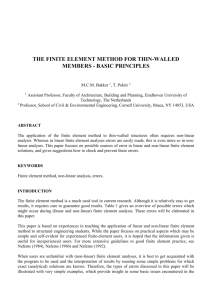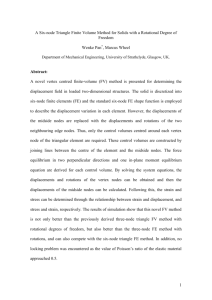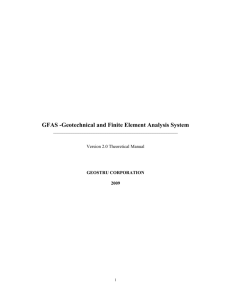Document
advertisement
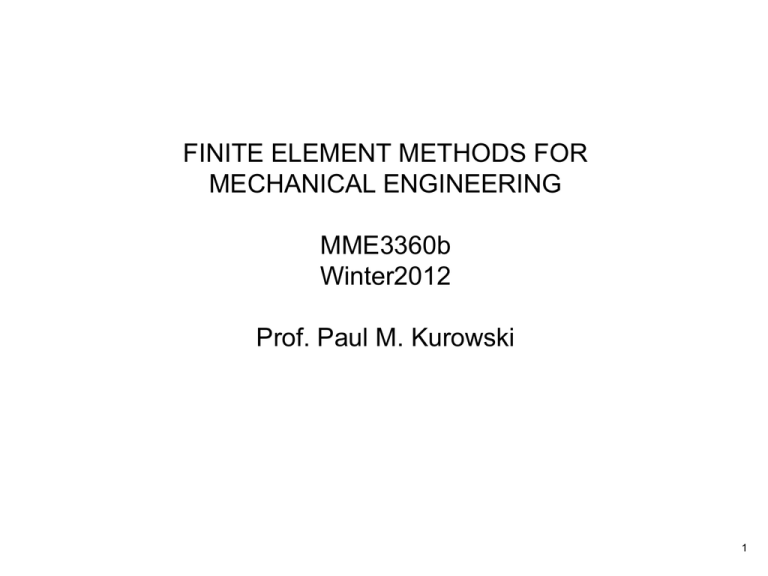
FINITE ELEMENT METHODS FOR
MECHANICAL ENGINEERING
MME3360b
Winter2012
Prof. Paul M. Kurowski
1
MME3360b web site
http://www.eng.uwo.ca/MME3360b/2012/
2
Design Center web site
http://www.eng.uwo.ca/designcentre/
3
SOFTWARE INSTALLATION
Questions? Ask Yara Hosein your TA
4
LAB THIS WEEK
Download and read it for Thursday lab if you
don’t have the book
Download for Thursday lab
5
3% BONUS
http://www.solidworks.com/sw/support/810_ENU_HTML.htm
6
MONKEY CLIMBING TWO ROPES
7
TWO ROPES
8
TEXT BOOKS
Recommended
Required
9
FUNDAMENTAL CONCEPTS OF
FINITE ELEMENT ANALYSIS
10
TOOLS OF DESIGN ANALYSIS
DESIGN
ANALYSIS
REAL
OBJECTS
MODELS
PHYSICAL
MODELS
MATHEMATICAL
MODELS
ANALYTICAL
NUMERICAL
FINITE ELEMENT
METHOD
FINITE DIFFERENCE
METHOD
BOUNDARY
ELEMENT METHOD
11
NUMERICAL TOOLS OF DESIGN ANALYSIS
Structural design analysis problems are described by a set of partial differential equations and belong to
the class called boundary value field problems. Such problems can be solved approximately by different
numerical methods.
Finite Element Method
Based on the variational formulation of a boundary value problem. In the FEM the
unknowns are approximated by functions generated from polynomials. The polynomials
are defined on standard elements (such as triangles and rectangles) which are then
mapped onto elements with (possibly) curved sides or faces and the continuity of the
mapped polynomials is enforced. These functions are effective for the reasons of numerical
efficiency. The solution domain must be divided (meshed) into elements that can be
mapped from the standard elements using mapping functions.
For reasons of numerical efficiency and versatility, most commercial analysis
systems are based on the Finite Element Method commonly called Finite Element
Analysis (FEA)
Finite Difference Method
Based on the differential formulation of a boundary value problem. This results in a densely
populated, often ill-conditioned matrix leading to numerical difficulties.
Boundary Element Method
Based on the integral equation formulation of a boundary value problem. This also results
in densely populated, non-symmetric matrix. Boundary Element Methods are efficient only
for “compact” 3D shapes.
12
BASIC STEPS IN THE FINITE ELEMENT ANALYSIS
Step 1
Creation of a mathematical model
An idealization of a real object accounting for geometry, loads, supports and material properties leads to a
formulation of a boundary value problem described by a set of governing partial differential equations. Most often
these equations are impossible to solve analytically and an approximate numerical method must be used.
Step 2
Deciding on the solution method
For reasons of numerical efficiency and generality we select the Finite Element Method.
Step 3
Approximating solution with piecewise polynomials
In order to represent solution with piecewise polynomials, we divide the body into simple shape sub domains
(elements) and define our polynomials (also called shape functions), with yet unknown factors ai , bi ,ci (also
called nodal degrees of freedom) in each of element separately.
N
u a p
x
i 1
i
ix
N
u b p
y
i 1
i
iy
N
u c p
z
i 1
i
iz
In the finite element method, nodal degrees of freedom are nodal displacements or temperatures.
Notice that by selecting certain polynomial order, we impose displacement pattern in each element. Working
with the first order polynomial (linear) we agree on linear displacement field, while second order polynomial will
return second order displacement field etc.
13
BASIC STEPS IN THE FINITE ELEMENT ANALYSIS
Continuous body - mathematical model
Discretized body – finite element model
Step 4
Finding nodal displacements
Now we use the principle of minimum total potential energy (the state of minimum total potential energy is also
the state of equilibrium) to find this set of ai , bi ,ci factors that minimizes the total potential energy of the body.
This is also the new state of equilibrium under load. Knowing ai , bi ,ci we can now calculate discertized
displacement anywhere in the body. Notice that displacements are primary unknowns and are calculated first.
Of course the accuracy of the results will depend on how well the exact solution can be approximated by the
particular design of the mesh and selection of the polynomial degrees.
Step 5
Finding strains and stresses
Once displacements have been found, we calculate strains as derivatives of displacements. Knowing strains
and material properties we can now find stresses.
14
BASIC STEPS IN THE FINITE ELEMENT ANALYSIS
Idealization of geometry
(if necessary)
Type of
analysis
Material
properties
Restraints
Loads
MATHEMATICAL
MODEL
CAD geometry
Simplified geometry
CAD
FEA Pre-processing
15
BASIC STEPS IN THE FINITE ELEMENT ANALYSIS
Numerical solver
Discretization
MATHEMATICAL
MODEL
FEA model
FEA Pre-processing
FEA results
FEA Solution
FEA Post-processing
16
FEA EQUATIONS
[F] = [K]*[d]
[F]
vector of nodal loads
known
[K]
stiffness matrix
known
[d]
vector of nodal displacements
unknown
17
CAD GEOMETRY AND FINITE ELEMENTS
GEOMETRY
3D
2D
GEOMETRIC
ELEMENTS
ENTITY MESHED
CREATED
Volume
Solids
Surface
Shells
Curve
Beams
Plane
Beams
18
DEGREES OF FREEDOM, SHAPE FUNCTIONS
1st order
tetrahedral element
Before
deformation
After
deformation
2nd order
tetrahedral element
Before
deformation
After
deformation
Degrees of freedom
Everything there is to know about the behaviour of this element under load can be calculated as soon as x, y
and z displacements of all nodes defining that element are found. x, y and z displacements components fully
describe node displacement for these 3D tetrahedral elements. x, y and z displacements are the three degrees
of freedom of each node.
Shape functions
The displacement at any point within the element is a function of nodal displacements. This function is called
shape function. In the first order element the shape function is a linear combination of nodal displacement, in the
second order element this a second order function etc.
19
DEGREES OF FREEDOM
With only one node restrained the
element spins in three directions.
With two nodes restrained the element
spins about the line connecting two nodes.
With three nodes restrained the
element won’t move.
Nodes of solid elements do not have rotational degrees of freedom.
DOF.SLDASM
20
DEGREES OF FREEDOM
Tetrahedral solid element
3 D.O.F. per node
Triangular shell element
6 D.O.F. per node
First order elements
Linear displacement
Constant stress
Second order elements
Second order displacement
Linear stress
Most often used element
21
TYPES OF ELEMENTS AND DEGREES OF FREEDOM
Solids
x, y and z nodal displacement components fully describe
behavior of each node. Each node has 3 D.O.F
Shells and beams
x, y and z displacements are not sufficient to describe what
is happening to each node while element deforms. Also
needed are rotations about x, y and z axis so each node
has 6 D.O.F.
2D plane stress, plane strain, axi-symmetric
x and y displacement fully describe behavior of each node.
Each node has two degrees of freedom.
22
TYPICAL ANALYSIS ASSUMPTIONS: LINEAR MATERIAL MODEL
Linear material model
[K] = const
Non-linear material model
Linear
range
[K] const
STRAIN
The linear material behavior complies with Hooke’s law:
= E
= G
in tension
in shear
23
TYPICAL ANALYSIS ASSUMPTIONS: SMALL DISPLACEMENTS
[K] = const
[K] const
To comply with assumptions of small displacements theory, the displacement must not change the stiffness in a significant way.
Note that displacements don’t have to be large to significantly change the stiffness.
24
3D STATE OF STRESS
State of stress expressed by six
stress components.
State of stress expressed by
three principal stresses.
25
VON MISES STRESS CRITERION
The maximum von Mises stress criterion is based on the von Mises-Hencky theory, also known as the
shear-energy theory or the maximum distortion energy theory. The theory states that a ductile material
starts to yield at a location when the von Mises stress becomes equal to the stress limit. In most cases, the
yield strength is used as the stress limit.
von Mises 0.5 * [( x y )
von Mises 0.5 * [( 1 2 )
y z)
2
(
2 3)
2
(
2
(
2
(
Factor of safety (FOS) = limit / von Mises
z x ) ] 3 * ( xy yz zx )
2
3 1 ) ]
2
2
2
2
THE MAXIMUM SHEAR STRESS CRITERION
Also known as Tresca yield criterion, is based on the Maximum Shear stress theory. This theory predicts
failure of a material to occur when the absolute maximum shear stress (max) reaches the stress that
causes the material to yield in a simple tension test. The Maximum shear stress criterion is used for
ductile materials.
max is the greatest of 12, 23 , 13
Where:
12 = (1 – 2)/2;
23 = (2- 3)/2;
Hence:
Factor of safety (FOS) = limit /(2*max)
13 = (1- 3)/2
THE MAXIMUM NORMAL STRESS CRITERION
Also known as Coulomb’s criterion is based on the Maximum normal stress theory. According to this theory
failure occurs when the maximum principal stress reaches the ultimate strength of the material for simple
tension.
This criterion is used for brittle materials. It assumes that the ultimate strength of the material in tension
and compression is the same. This assumption is not valid in all cases. For example, cracks decrease the
strength of the material in tension considerably while their effect is smaller in compression because the
cracks tend to close.
Brittle materials do not have a specific yield point and hence it is not recommended to use the yield
strength to define the limit stress for this criterion.
This theory predicts failure to occur when:
1 ≥ limit
where 1 is the maximum principal stress. Hence:
Factor of safety (FOS) = limit / 1
28
THE MOHR-COULOMB STRESS CRITERION
Is based on the Mohr-Coulomb theory also known as the Internal Friction theory. This criterion is used
for brittle materials with different tensile and compressive properties. Brittle materials do not have a
specific yield point and hence it is not recommended to use the yield strength to define the limit stress
for this criterion.
This theory predicts failure to occur when:
1 ≥ TensileLimit if 1 > 0 and 3 > 0
3 ≥ - CompressiveLimit if 1 < 0 and 3 < 0
1 / TensileLimit + 3 / CompressiveLimit < 1 if 1 ≥ 0 and 3 ≤ 0
The factor of safety is given by:
Factor of Safety (FOS) = {1 / TensileLimit + 3 / CompressiveLimit }(-1)
COMMON TYPES OF ANALYSES
STRUCTURAL
Linear static
Nonlinear static
Modal (frequency)
Linear buckling
THERMAL
Steady state thermal
Transient thermal
30
FINITE ELEMENT MESH
31
MESH COMPATIBILITY
There is only one
node here
There is only one
node here
There is only one
node here
There is only one
node here
Compatible elements
Incompatible elements
The same displacement shape function
along edge 1 and edge 2
Different displacement shape function
along edge 1 and edge 2
32
MESH COMPATIBILITY
Model of flat bar under tension. There is a mesh incompatibility along the mid-line
between left and right side of the model.
The same model after analysis. Due to mesh incompatibility a
gap has formed along the mid-line.
33
MESH COMPATIBILITY
Hinge
Solid
elements
Shell
elements
Shell elements and solid elements combined in one model.
Shell elements are attached to solid elements by links constraining their translational D.O.F. to D.O.F. of solid
elements and suppressing their rotational D.O.F. This way nodal rotations of shells are eliminated and nodal
translations have to follow nodal translations of solids.
Unintentional hinge will form along connection to solids if rotational D.O.F. of shells are not suppressed.
34
MESH QUALITY
Elements before mapping
Elements after mapping
35
MESH QUALITY
aspect ratio
angular distortion ( skew )
angular distortion ( taper )
curvature distortion
midsize node position
warpage
36
MESH QUALITY
Element distortion: aspect ratio
Element distortion: warping
37
MESH QUALITY
Element distortion: tangent edges
38
MESH ADEQUACY
Support
This stress distribution
needs to be modeled
Load
This stress distribution is modeled
with one layer of first order elements
39
MESH ADEQUACY
cantilever beam, model 1
terribly bad
cantilever beam, model 2
also terribly bad
cantilever beam model 3
a good beginning !
cantilever beam, model 4
an acceptable model
cantilever beam size:
modulus of elasticity:
load:
beam theory maximal deflection:
beam theory maximal stress:
10" x 1" x 0.1"
30,000,000psi
150 lbf
f = 0.2"
= 90,000psi
our definition of the discretization error :
( beam theory result - FEA result ) / beam theory result
model #
FEA
deflection
[in]
deflection
error
[%]
FEA
stress
[ PSI ]
stress
error
[%]
1
0.1358
32
1,500
98
2
0.1791
10
39,713
56
3
0.1950
2.5
65,275
27
4
0.1996
0.2
80,687
10
40
MESH ADEQUACY
Two layers of second order solid elements are generally recommended for modeling bending.
Shell elements adequately model bending.
41
CONVERGENCE PROCESS
CONTROL OF DISCRETIZATION ERROR
42
DISCRETIZATION OF STRESS DISTRIBUTION
Mesh built with first order triangular elements
called constant stress triangles
Discrete stress distribution in constant stress triangles
First order element assumes linear distribution of displacements within each element. Strain, being derivative of
displacement, is constant within each element. Stress is also constant because it is calculated based on strain.
43
DISCRETIZATION OF STRESS DISTRIBUTION
Tensile hollow strip modelled with a coarse
mesh of 2D plate elements.
An isometric view of von Mises effective stress distribution in
the upper right quarter of the model shown above. The height
of bars represents the magnitude of stress. Notice that
stresses are constant within each element.
44
CONVERGENCE ANALYSIS BY MESH REFINEMENT
The same tensile strip modelled three times with increasingly refined meshes. The
process of progressive mesh refinement is called h convergence.
45
CHARACTERISTIC ELEMENT SIZE
The process of progressive mesh refinement is called h convergence because
characteristic element size h is modified during this process
46
CONVERGENCE CURVE
Convergence criterion
Solution of the hypothetical “infinite”
Finite element model (unknown)
Solution error for
model # 3
Convergence error
for model # 3
# of D.O.F.
1
2
3
Mesh refinement and / or element order upgrade number
Discretization errors
Discretization error is an inherent part of FEA. It is the price we pay for discretization of a continuous structure.
Discretization error can be defined either as solution error or convergence error.
Convergence error
Convergence error is the difference between two consecutive mesh refinements and/or element order upgrade. Let’s say
convergence error is 10%. If convergence takes place, then the next refinement and/or element order upgrade will
produce results that will be different from the current one by less than 10%.
Solution error
The solution error is the difference between the results produced by a discrete model with a finite number of elements
and the results that would be produced by a hypothetical model with an infinite number of infinitesimal elements. To
estimate the solution error, one has to assess the rate of convergence and predict changes in results within the next few
iterations as if they were performed.
47
COMPARISON BETWEEN h ELEMENTS AND p ELEMENTS
h - elements
p - elements
The name h comes from characteristic
element size usually denoted as h.
The name p comes from polynomial function
describing displacement field in the element.
That characteristic element size is reduced
during h convergence process.
The order of polynomial function is increased
during p convergence process.
48
COMPARISON BETWEEN h ELEMENTS AND p ELEMENTS
h - elements
p - elements
Only tetrahedral
elements can be
reliably created
with the available
auto-meshers
Only tetrahedral
elements can be
reliably created
with the available
auto-meshers
Element shape: tetrahedral, wedge, hexahedral
Element shape: tetrahedral, wedge, hexahedral
Mapping allows for only little deviation from the ideal shape.
Mapping allows for higher deviation from the ideal shape but may
introduce errors on highly curved edges and surfaces
Displacement field mapped by lower order polynomials
(1st or 2nd), polynomial order does not change during
solution
Displacement field described by mapped higher order
polynomials, polynomial order adjusted automatically to
meet user’s accuracy requirements.
results are produced in one single run with
unknown accuracy
results are produced in the iterative process that continues
until the known, user specified accuracy, has been obtained
many small elements typically 5,000 – 500,000
fewer large elements typically 500 – 10,000
49
HOLLOW PLATE
Model file
HOLLOW PLATE.sldprt
Model type
solid
Material
Alloy Steel
Restraints
fixed to left end face
Load
100000N tensile load to right end face
Objectives
• meshing solid CAD geometry
• using solid elements
• demonstrating h convergence process
Fixed
restraint
100,000 N
tensile load
50
